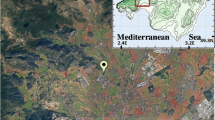Summary
The results presented in this paper are derived from the continuation of the use of two physically-based models of solar radiation and a steady state slope energy budget [1]. Again, climatic observational inputs (Northern Hemisphere Americas), averaged in 10-degree latitude bands, were utilized in order to compute the changing surface temperatures and differences between surface and air temperatures as functions of varying slope angles (0 to 90 degrees) and orientations (south-, west-, and north-facing). We continued to examine two contrasting landscapes: barren and grassy. No simple relations were found among the factors regarding shortwave and longwave radiative absorption, components of the energy budget, and surface temperature trends. A great diversity existed among surface temperatures of different slopes and orientations at any particular latitude. This was accentuated in the higher latitudes. These findings were assumed general enough to encompass most of the possible contrasts encountered in a real-world north-south transect.
Zusammenfassung
Die in dieser Arbeit vorgelegten Ergebnisse wurden mit Anwendung von zwei physikalisch begründeten Modellen der Sonnenstrahlung und einem Energiebudget eines Hanges abgeleitet. Es wurden über 10 Breitengrade der Nordhemisphäre Amerikas gemittelte klimatische Beobachtungsdaten als Eingaben zur Berechnung der Änderungen der Oberflächentemperaturen und der Differenzen zwischen Oberflächen- und Lufttemperaturen als Funktion verschiedener Hangneigungen (0 bis 90 Grad) und Orientierungen (süd-, west- und nordschauend) verwendet. Wir haben als Kontraste unbewachsene, und grasrbewachsene Landschaften vergleichend untersucht. Es wurden keine einfachen Beziehungen zwischen den die kurz- und langwellige Strahlungsabsorption betreffenden Faktoren, den Komponenten des Energiebudgets und den Tendenzen der Oberflächentemperatur gefunden. Eine große Verschiedenheit besteht zwischen den Oberflächentemperaturen verschiedener Hänge und Orientierungen in einer bestimmten Breite. Diese Ergebnisse werden für hinreichend dafür gehalten, die meisten der möglichen Gegensätze in einem Nord-Süd-Querschnitt in einer realen Welt zu erfassen.
Similar content being viewed by others
References
Terjung, W. H., O’Rourke, P. A.: A Simulation of Surface Temperatures for a North-South Latitudinal Transect during the Winter Solstice. Arch. Met. Geoph. Biocl., Ser. B32, 59–76 (1983).
Terjung, W. H., O’Rourke, P. A.: The Relative Effect of Solar Altitude on Surface Temperatures and Energy Budget Components on Two Contrasting Landscapes. Boundary-Layer Met.24, 67–76 (1982).
Terjung, W. H., O’Rourke, P. A.: A Worldwide Examination of Solar Beam-Slope Angle Values. Solar Energy31, 217–221 (1983).
Terjung, W. H., O’Rourke, P. A.: The Effects of Changing Solar Angles, Cloud Regimes, and Air Temperatures on the Temperatures of Contrasting Surfaces. Boundary-Layer Met.24, 269–279 (1982).
Terjung, W. H., O’Rourke, P. A.: Energy Budget Changes Caused by Varying Solar Angles, Cloud Scenarios, and Air Temperatures in Contrasting Landscapes. Int. J. Biomet.27, 3–16 (1983).
Terjung, W. H., O’Rourke, P. A.: Simulating Midday All-Slope Surface Temperatures Along a Climatic-Latitudinal Transect during Cloudless Summer Conditions. Boundary-Layer Met.24, 481–493 (1982).
Terjung, W. H., O’Rourke, P. A.: An All-Slope 24-Hour Summer Regime Along a Climatic-Latitudinal Transect. Boundary-Layer Met. (In press, 1983).
Meteorological Office: Tables of Temperature, Relative Humidity and Precipitation for the World. London: Her Majesty’s Stationery Office (1961-63).
Atwater, N. M., Ball, J. T.: A Numerical Solar Radiation Model Based on Standard Meteorological Observations. Solar Energy21, 163–170 (1978).
Atwater, M. A., Ball, J. T.: Erratum. Solar Energy23, 275 (1979).
Atwater, M. A., Brown, P. S.: Numerical Computations of the Latitudinal Variation of Solar Radiation for an Atmosphere of Varying Opacity. J. Appl. Met.13, 289–297 (1974).
Atwater, M. A., Lunde, P. J.: A Cloud-Cover Radiation Model Producing Results Equivalent to Measured Radiation Data. In: 1979 International Congress of the International Solar Energy Society, Atlanta, GA, 1979.
Terjung, W. H., O’Rourke, P. A.: Energy Exchanges in Urban Landscapes: Selected Climatic Models. Publications in Climatology, XXXIII, Elmer, N. J., Newark, Del.: C. W. Thornthwaites Associates and Center for Climatic Research, 1980.
Terjung, W. H., O’Rourke, P. A.: Simulating the Causal Elements of Urban Heat Islands. Boundary-Layer Met.19, 93–118 (1980).
Terjung, W. H., Louie, S. S-F.: A Climatic Model of Urban Energy Budgets. Geog. Analysis6, 341–367 (1974).
Terjung, W. H.: Reply to Dr. Idso. Boundary-Layer Met.25, 427 (1983).
Author information
Authors and Affiliations
Additional information
Dr. O’Rourke is currently a Visiting Scholar at UCLA from Litton Systems, Inc., Data Systems Division.
With 9 Figures
Rights and permissions
About this article
Cite this article
Terjung, W.H., O’Rourke, P.A. Simulating 24-hour, all-slope surface temperatures during summer along a climatic-latitudinal transect. Arch. Met. Geoph. Biocl., Ser. B 34, 49–63 (1984). https://doi.org/10.1007/BF02275674
Received:
Issue Date:
DOI: https://doi.org/10.1007/BF02275674




